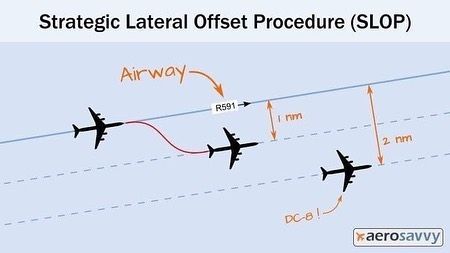
Strategic Lateral Offset Procedures (SLOP)
SLOP are approved procedures that allow aircraft to fly on a parallel track to the right of the center line relative to the direction of flight. An aircraft’s use of these procedures does not affect the application of prescribed separation standards. SLOP allows pilots to fly either the centreline, 1NM or 2NM to the right of centerline. SLOP may be applied from the Oceanic entry point, returning to centerline at the Oceanic exit point, by any aircraft with automatic offset programming capability”. Centerline SLOP

Our recommendation is not to fly the airway centreline unless you absolutely have to – which will be because ATC mandates it (ie. no SLOP allowed), or because your aircraft can’t (ie. It’s old). Although SLOP is generally allowed 0nm, 1nm, or 2nm right of track, the 0nm offset is by definition not an offset. Flying centreline:
Increases the risk of collision with opposite direction traffic, either erroneously at the same level as you, or carrying out an emergency descent and not turning away from the centerline as they should.
Increases the risk of wake turbulence from opposite direction traffic also on the centreline. *Note Aircraft flying offset tracks must have automatic offset tracking capability – something which is routinely provided in most modern Flight Management Systems. Flight crew are expected to determine the most suitable track using the best traffic information sources available to them. These may include RTF, Airborne Collision Avoidance System (ACAS), visual acquisition and Automatic Dependent Surveillance Broadcast (ADS-B). Communication with other aircraft in the vicinity using the air-to-air frequency 123.45 MHz may also facilitate useful co-ordination.
Author – Mohamed Freihat
(C130/L100 , A&C approved consultant)
